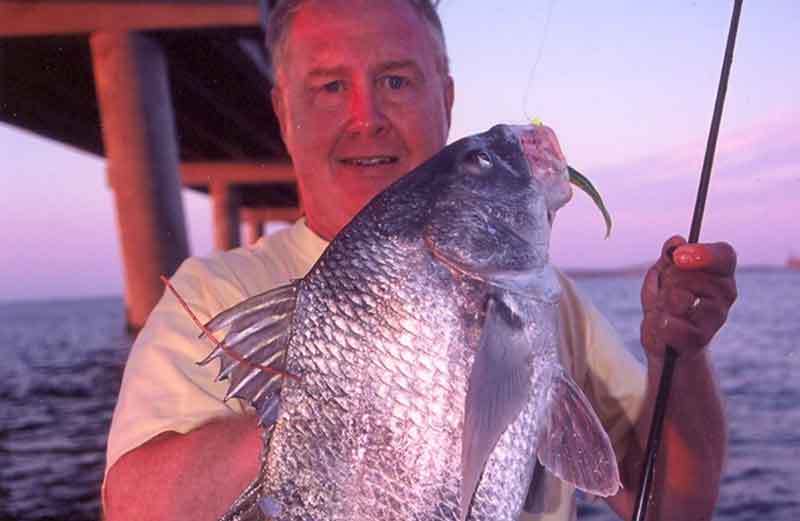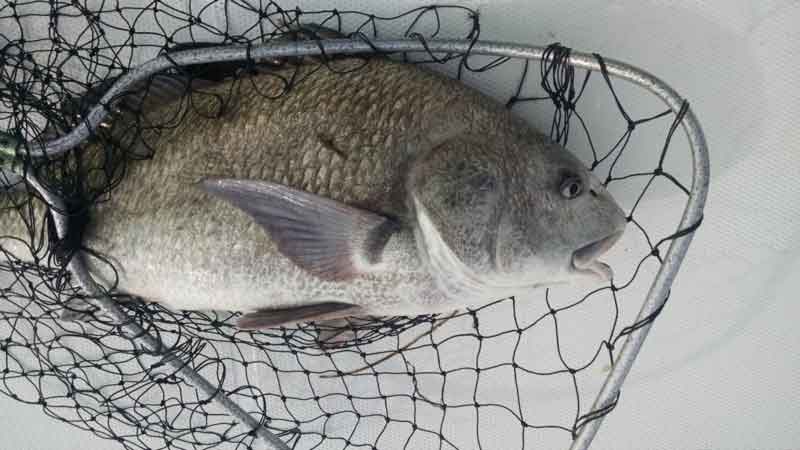Okay, I’ll admit it up front: in our area black drum don’t get the same respect as red drum. I don’t get it. Together with cobia, these two species make up one of those fishing “Grand Slams” that anglers seek. Of course, the ultimate Grand Slam is a blue marlin, white marlin, and sailfish caught on the same day, but in the Lower Chesapeake Bay the combination of the two drums with a cobia is sometimes referred to as a “Bay Grand Slam.” Much is written about cobia fishing (both sight fishing and chumming), and articles about red drum fishing are common. But little is written about the third member of this group—the black drum.

Black and red drum are members of the same fish family (Sciaenidae) along with speckled trout, grey trout, spot, croakers, and many others. The “drum” in their name refers to the sound that several members of the family make. Black drum and croakers are loud members of the family. When I had an aluminum johnboat, I could hear the drumming from a school of croakers swimming under my boat.
Black drum develop large scales as they grow. I remember seeing anglers bring in big ones and scale them with a garden hoe when I was a kid. Very few people in our area harvest large black drum anymore, however. And, to be honest, I rarely see anyone with smaller ones either, though they are very good to eat (larger ones are often riddled with worms, and don’t make for very good table fare; please release them gently from whence they came).
Black drum grow to over 100 pounds. Most of the fish I have caught have either been small (five to 10 pounds) or large (40 to 50 pounds). The fact that these fish can live to be 60 years old keeps me from harvesting an adult. I used to say I didn’t want to kill a fish as old as I am. Now that I am in my mid-60s, that line doesn’t work anymore.
Where to Find Black Drum in the Lower Bay
Large black and red drum often hang out in the same areas. Most of the black drum fishing I have done has been for large fish, often off the Bay side of the Eastern Shore, and around the CBBT. These fish spawn in the Bay, and a lot of juveniles have been tagged in the Virginia Marine Resources Commission tagging program. These young fish used to be caught in pound nets off Cape Charles. On the other side of the Bay where I live, we rarely see small black drum. However, you will catch the smaller ones at the Chesapeake Bay Bridge Tunnel.
Throughout the summer, large black drum may be found along the sides of any of the four islands of the CBBT. This used to be a much more predictable fishery, but we haven’t seen them as much in recent years. They swim in big schools sometimes visible from the surface. On calm days, you can spot the school because they cause the color of the water to change. They may also be found right up in the rocks of the islands.
Best Baits for Black Drum
Black drum like to eat shellfish. Back in the day, old timers would soak a crab and clam “sandwich” on the bottom using heavy tackle. This bait consisted of a whole or half crab and a large clam usually held onto the hook by a rubber band. Though I no longer employ this combination, we have caught plenty of black drum mixed in with red drum on the shoals near the north end of the bridge tunnel in May and June using crabs for bait.

You can also target them using spinning gear with leadhead jigs. The jigs I use for casting to schools of black drum tend to be about 3/4 of an ounce with about a 7/0 hook. I pair this with a paddle tail or mullet tail. I’ve caught them on smaller jigs, but they are more likely to straighten or pull the hook—black drum have very tough mouths with big rubbery lips. This works well for crunching on shellfish, but it makes it hard to get a good hookset. It’s not uncommon that you will pull the hook after a long fight, with the fish in sight of the boat.
Black drum fight differently than red drum. A red is likely to take off in a long run when hooked. Blacks are more likely simply to try and swim back to their school. They are slower than reds but put up a determined fight. Sometimes the school will have some younger fish. If you hook one of these smaller fish, they tend to act more like red drum.
If you ever fish down on the Outer Banks you’ll catch young black drum there as well. I love to fish the “Little Bridge” on the causeway that goes from the Outer Banks to Manteo, it’s a great location for specks and puppy drum. Several years ago, I discovered that if you toss shrimp up under the bridge on a bottom rig you may find five-pound black drum there as well.
Once you do land a large black drum, you will notice that they are one of the slimiest fish in the ocean. It’s tempting to hoist the fish onto your lap for a picture. I know, I’ve done that more than once. If you do, he’ll leave you with a coat of slime that doesn’t wash out of your clothes very well. Whatever you do, return the fish to the water as quickly as possible. Revive him next to the boat and release him to swim back to his school.
Harvesting Black Drum
Currently, you can keep one black drum over 16 inches per angler per day in both Virginia and Maryland. While I never kill big ones, sometimes I will keep a smaller one for the table. (Editor’s note: while the correct harvesting size is debatable, it should be pointed out that fish of 20 pounds or less rarely have worm issues. Fish larger than that often end up being thrown away when the angler finds all those worms, so it’s a good cut-off point to use for harvest versus catch and release). A 46-inch fish will get you a release citation in Virginia and a 48-incher does the trick in Maryland, providing you have a clear picture of the fish next to a measuring device.
I always say that black drum remind me of giant spot, and red drum remind me of giant croakers. Black drum may be much bigger around than their red cousins, but the meat on a black drum is still white and flaky, with a mild taste. They are good fried, baked, and made into fish cakes, and to my mind, they taste a whole lot better than red drum. This is another way in which these two species resemble spot and croakers—I much prefer the taste of spot over croakers.
So, whether you are looking for something different to target, or you just want a good fight with a large fish, black drum can fill the bill. And, if you are lucky enough to find a small one, you’ll have a good dinner as well.
A Word on Black Drum, from the VMRC
I reached out to Lewis Gillingham of the Virginia Marine Resources Commission. Lewis oversees the Virginia Saltwater Fishing Tournament (the “citation” program), and the tagging program. Lewis said:
“Black drum must weigh at least 80 pounds for a weight Citation or 46 inches for a release. I sense there really is not as much interest in these bigger fish, perhaps because there are fewer available, as in years past. You are right about the schools of large black drum around the islands during the summer months—I’m just not hearing about them. Coincidently, the only weight Citation in 2019 was caught in October at the Monitor and Merrimac Bridge Tunnel crossing on a piece of peeler crab and it weighed 88 pounds. There is still a spring directed fishery for them on the bayside around the Cape Charles area, but those folks are looking for fish to keep and eat. On the seaside, primarily the little piece of Assateague Island that is in VA, there is a directed shore fishery and they generally take black drum in the 10- to 20-pound range.”
Lewis sent me some graphs that indicated the best years for black drum citations were way back in the mid-1970s. Once release citations were offered, they showed many more releases with the best years around 2003 and 2007. His figures seemed to reinforce my feeling that there are fewer big black drum around these days. But, as we have seen with other species, this can change practically overnight.
Another of the charts he sent indicated that 2019 was a good year for tagging (mostly smaller fish). Most years have seen between 100 and 200 back drums tagged and released. It is also interesting that the number of recaptured tagged fish for black drum are rather low (less than 10 in most years). The number of recaptured fish in 2019 and already in 2020 has gone up.
Black Drum in Maryland

In Maryland waters, the targeted black drum fishery (which mostly takes place from mid-May through mid- to late-June) is mostly limited to the two- to four-week run at the Stone Rock after a briefer run usually off Jane’s Island, though these fish do pop up sporadically throughout the Bay all summer long. This fishery has been quiet the past few years, and does historically run in cycles. Want more info? We have a full feature on targeting black drum that includes sections or targeting them at the Stone Rock—a completely different fishery, utilizing soft crab and a sharp eye on the fishfinder.
-By Chuck Harrison